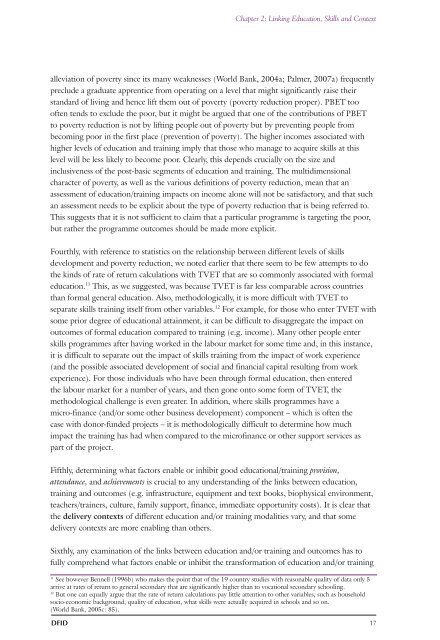Educating out of Poverty? A Synthesis Report on Ghana, India ... - DfID
Educating out of Poverty? A Synthesis Report on Ghana, India ... - DfID
Educating out of Poverty? A Synthesis Report on Ghana, India ... - DfID
Create successful ePaper yourself
Turn your PDF publications into a flip-book with our unique Google optimized e-Paper software.
Chapter 2: Linking Educati<strong>on</strong>, Skills and C<strong>on</strong>text<br />
alleviati<strong>on</strong> <str<strong>on</strong>g>of</str<strong>on</strong>g> poverty since its many weaknesses (World Bank, 2004a; Palmer, 2007a) frequently<br />
preclude a graduate apprentice from operating <strong>on</strong> a level that might significantly raise their<br />
standard <str<strong>on</strong>g>of</str<strong>on</strong>g> living and hence lift them <str<strong>on</strong>g>out</str<strong>on</strong>g> <str<strong>on</strong>g>of</str<strong>on</strong>g> poverty (poverty reducti<strong>on</strong> proper). PBET too<br />
<str<strong>on</strong>g>of</str<strong>on</strong>g>ten tends to exclude the poor, but it might be argued that <strong>on</strong>e <str<strong>on</strong>g>of</str<strong>on</strong>g> the c<strong>on</strong>tributi<strong>on</strong>s <str<strong>on</strong>g>of</str<strong>on</strong>g> PBET<br />
to poverty reducti<strong>on</strong> is not by lifting people <str<strong>on</strong>g>out</str<strong>on</strong>g> <str<strong>on</strong>g>of</str<strong>on</strong>g> poverty but by preventing people from<br />
becoming poor in the first place (preventi<strong>on</strong> <str<strong>on</strong>g>of</str<strong>on</strong>g> poverty). The higher incomes associated with<br />
higher levels <str<strong>on</strong>g>of</str<strong>on</strong>g> educati<strong>on</strong> and training imply that those who manage to acquire skills at this<br />
level will be less likely to become poor. Clearly, this depends crucially <strong>on</strong> the size and<br />
inclusiveness <str<strong>on</strong>g>of</str<strong>on</strong>g> the post-basic segments <str<strong>on</strong>g>of</str<strong>on</strong>g> educati<strong>on</strong> and training. The multidimensi<strong>on</strong>al<br />
character <str<strong>on</strong>g>of</str<strong>on</strong>g> poverty, as well as the various definiti<strong>on</strong>s <str<strong>on</strong>g>of</str<strong>on</strong>g> poverty reducti<strong>on</strong>, mean that an<br />
assessment <str<strong>on</strong>g>of</str<strong>on</strong>g> educati<strong>on</strong>/training impacts <strong>on</strong> income al<strong>on</strong>e will not be satisfactory, and that such<br />
an assessment needs to be explicit ab<str<strong>on</strong>g>out</str<strong>on</strong>g> the type <str<strong>on</strong>g>of</str<strong>on</strong>g> poverty reducti<strong>on</strong> that is being referred to.<br />
This suggests that it is not sufficient to claim that a particular programme is targeting the poor,<br />
but rather the programme <str<strong>on</strong>g>out</str<strong>on</strong>g>comes should be made more explicit.<br />
Fourthly, with reference to statistics <strong>on</strong> the relati<strong>on</strong>ship between different levels <str<strong>on</strong>g>of</str<strong>on</strong>g> skills<br />
development and poverty reducti<strong>on</strong>, we noted earlier that there seem to be few attempts to do<br />
the kinds <str<strong>on</strong>g>of</str<strong>on</strong>g> rate <str<strong>on</strong>g>of</str<strong>on</strong>g> return calculati<strong>on</strong>s with TVET that are so comm<strong>on</strong>ly associated with formal<br />
educati<strong>on</strong>. 11 This, as we suggested, was because TVET is far less comparable across countries<br />
than formal general educati<strong>on</strong>. Also, methodologically, it is more difficult with TVET to<br />
separate skills training itself from other variables. 12 For example, for those who enter TVET with<br />
some prior degree <str<strong>on</strong>g>of</str<strong>on</strong>g> educati<strong>on</strong>al attainment, it can be difficult to disaggregate the impact <strong>on</strong><br />
<str<strong>on</strong>g>out</str<strong>on</strong>g>comes <str<strong>on</strong>g>of</str<strong>on</strong>g> formal educati<strong>on</strong> compared to training (e.g. income). Many other people enter<br />
skills programmes after having worked in the labour market for some time and, in this instance,<br />
it is difficult to separate <str<strong>on</strong>g>out</str<strong>on</strong>g> the impact <str<strong>on</strong>g>of</str<strong>on</strong>g> skills training from the impact <str<strong>on</strong>g>of</str<strong>on</strong>g> work experience<br />
(and the possible associated development <str<strong>on</strong>g>of</str<strong>on</strong>g> social and financial capital resulting from work<br />
experience). For those individuals who have been through formal educati<strong>on</strong>, then entered<br />
the labour market for a number <str<strong>on</strong>g>of</str<strong>on</strong>g> years, and then g<strong>on</strong>e <strong>on</strong>to some form <str<strong>on</strong>g>of</str<strong>on</strong>g> TVET, the<br />
methodological challenge is even greater. In additi<strong>on</strong>, where skills programmes have a<br />
micro-finance (and/or some other business development) comp<strong>on</strong>ent – which is <str<strong>on</strong>g>of</str<strong>on</strong>g>ten the<br />
case with d<strong>on</strong>or-funded projects – it is methodologically difficult to determine how much<br />
impact the training has had when compared to the micr<str<strong>on</strong>g>of</str<strong>on</strong>g>inance or other support services as<br />
part <str<strong>on</strong>g>of</str<strong>on</strong>g> the project.<br />
Fifthly, determining what factors enable or inhibit good educati<strong>on</strong>al/training provisi<strong>on</strong>,<br />
attendance, and achievements is crucial to any understanding <str<strong>on</strong>g>of</str<strong>on</strong>g> the links between educati<strong>on</strong>,<br />
training and <str<strong>on</strong>g>out</str<strong>on</strong>g>comes (e.g. infrastructure, equipment and text books, biophysical envir<strong>on</strong>ment,<br />
teachers/trainers, culture, family support, finance, immediate opportunity costs). It is clear that<br />
the delivery c<strong>on</strong>texts <str<strong>on</strong>g>of</str<strong>on</strong>g> different educati<strong>on</strong> and/or training modalities vary, and that some<br />
delivery c<strong>on</strong>texts are more enabling than others.<br />
Sixthly, any examinati<strong>on</strong> <str<strong>on</strong>g>of</str<strong>on</strong>g> the links between educati<strong>on</strong> and/or training and <str<strong>on</strong>g>out</str<strong>on</strong>g>comes has to<br />
fully comprehend what factors enable or inhibit the transformati<strong>on</strong> <str<strong>on</strong>g>of</str<strong>on</strong>g> educati<strong>on</strong> and/or training<br />
11 See however Bennell (1996b) who makes the point that <str<strong>on</strong>g>of</str<strong>on</strong>g> the 19 country studies with reas<strong>on</strong>able quality <str<strong>on</strong>g>of</str<strong>on</strong>g> data <strong>on</strong>ly 5<br />
arrive at rates <str<strong>on</strong>g>of</str<strong>on</strong>g> return to general sec<strong>on</strong>dary that are significantly higher than to vocati<strong>on</strong>al sec<strong>on</strong>dary schooling.<br />
12 But <strong>on</strong>e can equally argue that the rate <str<strong>on</strong>g>of</str<strong>on</strong>g> return calculati<strong>on</strong>s pay little attenti<strong>on</strong> to other variables, such as household<br />
socio-ec<strong>on</strong>omic background, quality <str<strong>on</strong>g>of</str<strong>on</strong>g> educati<strong>on</strong>, what skills were actually acquired in schools and so <strong>on</strong>.<br />
(World Bank, 2005c: 85).<br />
DFID 17

















